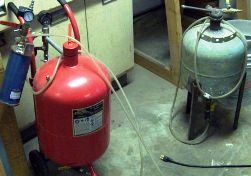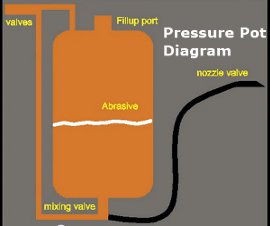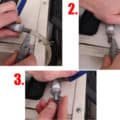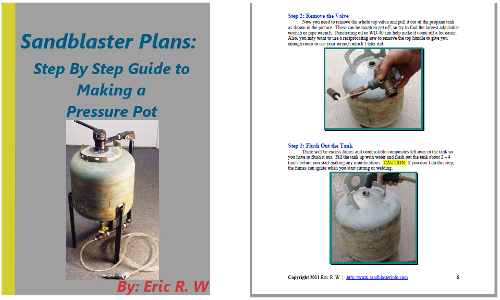There are many different pressure blaster pot sizes to chose from, and a lot of people have trouble deciding what size will be best. So, hopefully I can help you narrow in on the right size to fit your needs in this post.

Picture of my 40 lb on the left, and my homemade smaller size on the right which is has about a 20-30 lb capacity.
I want to first say that I etch for fun mainly, and the 40lb tank is just about perfect for me. There are many sizes available, but most shops will have 3 basic sizes. The most common of these floor shop grades are the 20 lb, 40 lb, and 90 lb. This stands for how many pounds of abrasive the tank can hold. It is categorized in this scale because the sandblasting industry typically sells abrasive by weight. You will notice that some equipment companies will also sell blasters by gallons which might make it confusing.
Anyway, here is what I recommend for each size:
- 20 lb– this size is great for people that infrequently blast for a hobby or if they work with smaller items like glass mugs. It’s okay to use it for sandcarving small objects, but you may have to refill it after blasting 1-5 small sandcarving projects.
- 40 lb– this size can be used for those that would like to do more sandcarving work and blast every once in awhile. It’s great for small to medium large projects. This size will likely be ideal for most people.
- 90 lb– the larger size is recommended for those that want to start a business etching numerous items continuously without stopping, and for larger sandcarving projects.
Aspects of Larger Pots
I always tell people that the 40 lb is a great size for most people, but it also has some positive aspects in comparison to the smaller 20 lb blaster. But these additional items aren’t expensive and can be easily added to the 20 lb system. These additional aspects are included on the Central Pneumatic 40 lb sandblaster:
- The use of a pressure gauge, so you can monitor the pressure and adjust the air pressure setting for the desired power. (A pressure gauge isn’t expensive and can be connected later if desired, but not needed.)
- The use of an air/water filter (a.k.a. air separators), so moisture and contaminants are extracted from the compressed air before being placed in the pressure pot. I definitely recommend that you use this filter to prevent moisture from getting mixed into the abrasive which causes it to harden. If this happens, the abrasive will need to be removed from the container and dried. (Good air filters are also fairly inexpensive, as low as $10 and can be connected anytime.)
Share this on social media or email by clicking below!




